PMC/PubMed Indexed Articles
Indexed In
- Open J Gate
- The Global Impact Factor (GIF)
- Open Archive Initiative
- VieSearch
- International Society of Universal Research in Sciences
- China National Knowledge Infrastructure (CNKI)
- CiteFactor
- Scimago
- Ulrich's Periodicals Directory
- Electronic Journals Library
- RefSeek
- Directory of Research Journal Indexing (DRJI)
- Hamdard University
- EBSCO A-Z
- Publons
- Google Scholar
Useful Links
Share This Page
Journal Flyer

Open Access Journals
- Agri and Aquaculture
- Biochemistry
- Bioinformatics & Systems Biology
- Business & Management
- Chemistry
- Clinical Sciences
- Engineering
- Food & Nutrition
- General Science
- Genetics & Molecular Biology
- Immunology & Microbiology
- Medical Sciences
- Neuroscience & Psychology
- Nursing & Health Care
- Pharmaceutical Sciences
Original Research Article - (2020) Volume 10, Issue 2
Polythene Waste Management – Challenges and Opportunities in Rivers State, Nigeria
Edene Osemhen Stanley*, Ehirim Chiudo, Anao Osemudiamen, Maduekwe Chinenyem and Obele RealmanReceived: 12-Feb-2020 Published: 03-Mar-2020, DOI: 10.35248/2252-5211.20.10.377
Abstract
The aim of this study was to assess the challenges and opportunities of managing polythene waste products (“pure water” sachets) in Port Harcourt city, Rivers State, Nigeria. The study also investigated the current waste management practices in the area. The findings of the study showed that more than 70,000,000 (70 million) ‘pure water’ sachets are generated monthly in Port Harcourt and environs. Twenty-five percent (25%) of respondents to questionnaires reuse polythene packages after the primary contents have been consumed; 75% of respondents do not reuse polythene packages. Among those who do not reuse the packages, 38% dump the packages into streets, gutters, rivers and other areas. It is suggested that recycling of polythene wastes is encouraged in the study area. By means of campaigns and other suasive instruments, the State Government should increase awareness of the environmental and health impacts of improper disposal of polythene waste packages. A deposit-refund scheme (DRS) is recommended as an appropriate potentially effective policy instrument for polythene waste recycling programme.
Keywords
Polythene waste; Pollution; Management; Port Harcourt
Introduction
Polythene materials are used widely in many consumer products and its consumption has increased exponentially in the past decades. In most urban and rural areas in Nigeria, polythene bags litter the landscape, presenting an ugly and unhygienic scene. Improper disposal of polythene creates environmental pollution and space problem because they are not easily biodegraded [1]. The wastes also clog drainages leading to flooding as witnessed in Port Harcourt as well as Lagos and Onitsha in year 2011. The blocked drains are difficult and costly to maintain. Hence, there is need to adopt effective waste management approaches in order to resolve environmental pollution caused by polythene wastes.
Recycling has been advocated as an effective approach to managing polythene wastes in Nigeria. The reuse of the waste polythene products such as the conversion from sachet water bags into candle products has been reported by Edoga et al. [2] and other reuse product such as fuel oil [3]. This paper examines the challenges and opportunities of polythene waste management in Port Harcourt and environs of Rivers State. The objectives of this research were to:
• Obtain information on waste management practices in the study area;
• Evaluate public awareness of the health/environmental impacts of improper disposal of polythene bags;
• Assess current challenges of polythene waste management;
• Assess opportunities in proper handling of polythene waste; and
• Make appropriate recommendations for sustainable management of polythene waste by recycling.
Area of Study
This study was carried out in Port Harcourt and its environs within Rivers State. Rivers State is one of the thirty-six (36) states of Nigeria and has twenty-three (23) local government areas (Figure 1).
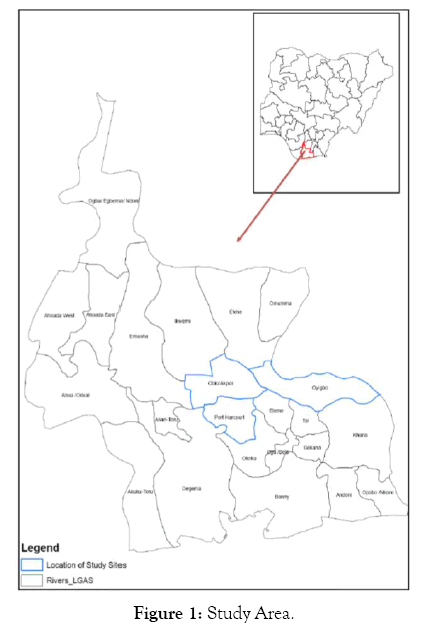
Figure 1: Study Area.
The parts bound by blue lines are local government areas that belong to the new Greater Port Harcourt urban area. This area spans eight local government areas that include Port Harcourt, Okrika, Obio/Akpor, Ikwerre, Oyigbo, Ogu/Bolo, Tai and Eleme local governments. The Greater Port Harcourt Area is being developed to decongest the old Port Harcourt city. The study area features a tropical monsoon climate with lengthy and heavy rainfall season and very short dry season.
Basically, there is inadequate documentation on the waste generated in the State. However, from the findings of a study conducted by Fugro Nigeria, the percentage of organic materials, paper and plastics is high.
Study Methodology
The approach adopted in carrying out the study included primary and secondary data collection, as well as data analysis/interpretation. Primary data were obtained by means of photographs, interviews, and observations. Secondary data were obtained from documents on the subject of polythene waste management. Desktop studies were undertaken to also gain an understanding of the existing environment; materials consulted include books, research articles, reports, and aerial photograph.
Preliminary actions
This phase involved literature search, selection of study area (Port Harcourt city and environs) and facilities to be visited, as well as development of study methodology and field work plan.
Site visit/data collection
Primary data were obtained through photographs and administration of questionnaires/interviews as well as observations. Secondary data were obtained from documents such as publications on polythene waste and management with particular emphasis on polythene packages.
Fieldwork implementation
Prior to field investigations, an appropriate questionnaire was developed. Quality checks were carried out on the camera used for the field exercise. The checks were to ensure that the field tools were functional.
Field data acquisition was to ascertain current practice on management of polythene waste and assess opportunities for improved management. The field visits were conducted between 26/11/2012 and 30/11/2012. Three (3) water packaging facilities and one (1) polythene recycling firm were visited: Nobel Water; Junac Water; Zina Water; and Safari Polyproducts. Appropriate questionnaires were distributed in order to obtain information on polythene waste management and knowledge of effects of improper disposal of polythene waste.
Waste burden estimation
Polythene utilising facilities other than ‘pure water’ packaging facilities were not visited hence; estimation of polythene waste burden is based on information on ‘pure water’ sachets. However, the process of recycling the used sachets is the same for other forms of used polythene. Thus, the findings of this study can be applied to polythene products in general.
The quantity of used polythene bags generated in the study area was estimated from the records of packaged water manufacturers. That is by inductive inference, the amount of packaged water sold per period is assumed to be the amount of used packages generated as ‘waste’.
Data analysis/interpretation
Deductions were made of the information obtained from the field. Other information was analysed/ interpreted by statistical methods. The study area, Port Harcourt and environs, was divided into thirty-five (35) quadrants of 25 km2 each, and ¼ of one (1) quadrant was studied (Figure 2). The results of the study of the selected quadrant (in and around the University of Port Harcourt), was extrapolated for the other thirty-four (34) and ¾ quadrants. The final results compared favourably with those of previous studies of other Nigerian cities [1,4,5].
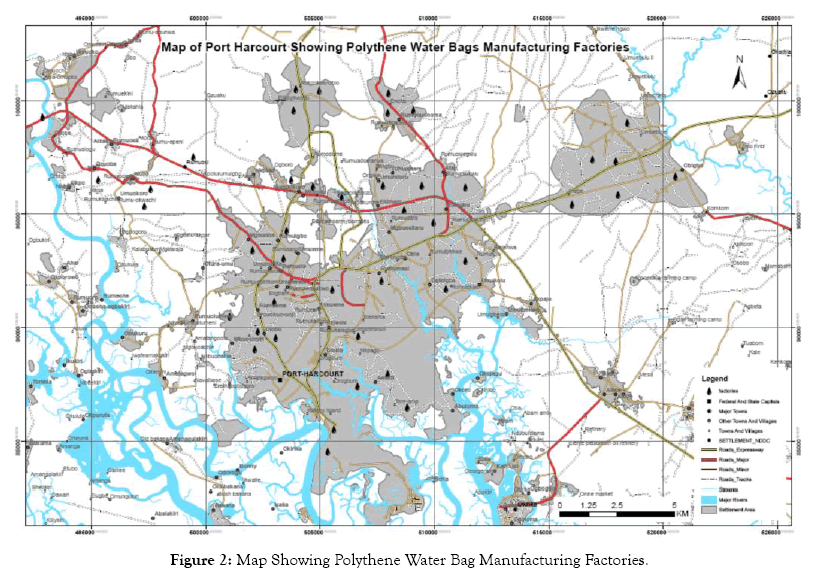
Figure 2: Map Showing Polythene Water Bag Manufacturing Factories.
Results and Discussions
An average of 2,000 bags of sachet water is sold daily by each of the three (3) water packaging facilities visited in the study area – ¼ of one (1) quadrant. It is estimated that about eight (8) water packaging facilities are in the area. Thus, some 16,000 bags of sachet water are sold daily in the area and 480,000 bags in a month. Each bag contains twenty (20) sachets, hence monthly, about 9,600,000 sachets are sold. By extrapolation, the entire Port Harcourt and environs (including the other thirty-four and three-quarter quadrants) generate more than 1,000, 000,000,000 (1 billion) ‘pure water’ sachets monthly. Consumption of water increases during the dry season and this translates to more sachets produced and disposed in the dry season.
Prevailing practice
All the respondents to the questionnaires for this research reported that they use polythene packaged products. The method of disposal of the used packages (Figure 3) as well as public awareness about the health and environmental effects of improper management of the waste was investigated.
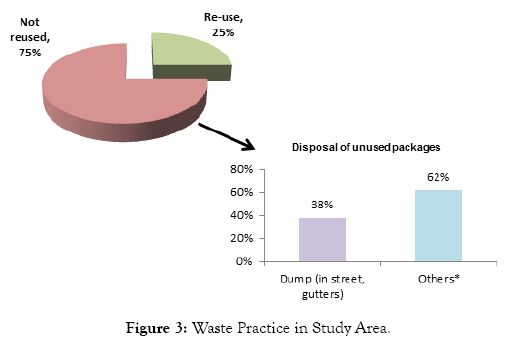
Figure 3: Waste Practice in Study Area.
In the study area, 25% of respondents reuse the polythene packages after the primary contents have been consumed; 75% of respondents do not reuse polythene packages. Among those who do not reuse the packages, 38% dump the packages into streets, gutters and rivers while 62% dispose in open dumps or store in containers for evacuation by waste collectors. None of the respondents burn their wastes or supply the wastes to recyclers.
Public awareness of effects
The level of public awareness of the health and environmental effects of improper management of polythene waste was determined to be high (Figure 4); five (5) in eight (8) persons were aware. Sixty-two percent (62%) of respondents were aware of the health and environmental effects of improper management of polythene wastes; thirty-eight (38%) were unaware. Awareness was higher among (1) post-secondary education level respondents and (2) those that were from 20 years of age and above.
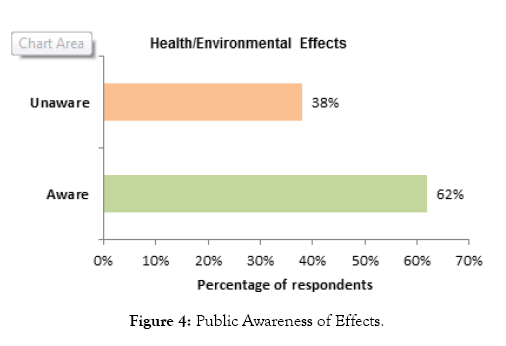
Figure 4: Public Awareness of Effects.
Social infrastructure
Provision of adequate infrastructure such as waste storage, collection and handling facilities is important for effective waste management. Such infrastructure includes roads, platforms and transfer stations for solid waste management. There was a dearth of adequate and suitable infrastructure available in the study area (Figure 5).
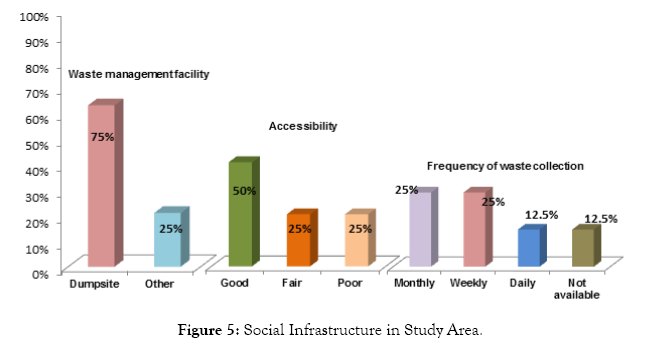
Figure 5: Social Infrastructure in Study Area.
The commonest waste ‘management’ method in the area was disposal at dumpsites (this includes open dumping onto streets, drainages and water ways). Half of respondents have good access to the available dumpsites. In 25% of the study area, dumpsites were not available. The frequency of collection of wastes from skids and waste storage units was monthly in 25% and weekly in another 25% of study area. In less than ¼ of the area was waste collected daily while in another ¼ of the area, there were no waste collection services. These results correlate with the observed unsightly scenes and blocked drainages in many places.
Expectedly, locations without waste collection facilities as well as locations with collection facilities but for which frequency of collection was weekly/monthly recorded higher levels of waste polythene materials.
Local governance/enforcement
Several laws and edicts have been passed that pertain to waste management in Rivers State in particular and Nigeria in general and institutions have been established to enforce the laws. More than 85% of respondents in the study area reported the non-existence of local enforcement of waste management laws. Respondents omitted the mandatory ‘environmental sanitation’ for residents of Port Harcourt and environs; however, it must be acknowledged that ‘environmental sanitation’ is regularly enforced. There were no local environmental awareness programmes reported by any of the respondents however, there are State sponsored jingles and television commercials to increase awareness of environmental/ health impacts of improper waste disposal.
Challenges
The findings of this study are limited by the sample size due to time constraints.
Recommendations
Recycling of polythene waste should be encouraged. The wastes could be collected and sold to recycling firms. Also, polythene manufacturers could re-claim reusable/recyclable packages of their products from consumers and reuse them. The government may direct such manufacturers to reclaim their packaging from end-users or from the streets. Cost-effective high achieving plastic collection could be achieved by integrating used polythene collection with other recyclable materials. Boxes designated for polythene and other plastics collection can be placed by roadsides for easy segregation by refuse collectors.
Government regulations
Legislations could be passed that require say, water packaging facilities, supermarkets and large drug stores to institute plastic bag recycling programmes and make reusable bags available. Among other measures, the statute should require stores to: (1) provide bins to collect used plastic bags; (2) print on each bag the message “Please Return to a Participating Store for Recycling”; and (3) maintain records for at least three (3) years documenting recycling activities.
Suasive instruments
Government and other responsible bodies should continue antilitter and environmental awareness campaigns. Waste management education could be introduced in school curriculum (perhaps from elementary school); school children should be taught that littering is irresponsible and not a proper way of disposing of waste [6].
Deposit-refund systems
A deposit–refund system is a method of pollution control in which the buyers or consumers of a polluting product pay a surcharge, which is later refunded to them when they return the used packaging of the product or it’s leftover to a point of purchase or designated center. The purpose of this is to make the used packaging available for reuse, recycling or proper disposal in order to curb pollution [7]. The deposit-refund scheme is based on user pays-principles (UPP) which emanates from the thinking that the consumers of goods and services which generate pollution should be made to share in the abatement cost. The scheme is also based on the principle that incentives should be provided to encourage waste recovery or reclamation, and recycling. The deposit levied on the polluting product represents a charge designed to cover the costs of waste disposal in the event that the used packaging or leftovers are not returned for recycling or safe disposal. But when they are returned to the designated collection points, the supplier gives either a total (or partial) refund of the initial deposit, depending on the economics of recovery or recycling of the material [7,8].
Conclusion
Consumers in the study area were generally aware of the health and environmental effects of improper management of polythene waste. Yet, the study area was littered with large quantities of used polythene packages. One reason for this is the inadequacy of waste management infrastructure in the study area. Waste management measures such as increasing awareness of environmental/health effects of improper waste management, encouraging recycling by legislations and perhaps a deposit-refund system (DRS) could improve existing conditions. The pivot of this scheme is recycling (that provides potential polluters with incentives – refund deposits – to disengage from polluting activities); which creates employment opportunities and enhance economic growth and development.
REFERENCES
- Ukpong EC, Peter Chamberlain M. Material Recovery from Polythene Recycle As An Environmental Pollutant In Nigeria. Continental J Water, Air and Soil Pollution. 2011;2:31 -41.
- Edoga MO, Onyeji LI, Oguntosin OO. Achieving vision 20:2020 through Waste Produced Candle. Journal of Engineering and Applied Sciences. 2008;3:642-646.
- Jalil PA. Investigation on Polyethylene Degradation into Fuel Oil Over Tungs to Phosphoric Acid Supported on Mesoporous Silica. Journal of Analytical and Applied Pyrolysis. 2002;65:185-195.
- Ibadan CPE. Centre for People and Environment. Landfill Recovery and Use in Nigeria (prefeasibility studies of using LFGE) – final report. 2010.
- Ogwueleka T Ch. Municipal Solid Waste Characteristics and Management in Nigeria. Iran Journal of Environmental Health, Science and Engineering. 2009;6:173–180.
- Rosen HS. Public Finance. Irwin/McGraw-Hill, Boston. 1999.
- Jerome A. The Use of Economic Instruments for Environmental Management in Nigeria. Proceedings of the Nigerian Economic Society Annual Conference, Port-Harcourt, Nigeria. 2001.
- Babatunde A, Biala I. Externality Effects of Sachet Water Consumption and the Choice of Policy Instruments in Nigeria: Evidence from Kwara State. J Economics. 2010;1:113-131.
Citation: Stanley EO, Chiudo E, Osemudiamen A, Chinenyem M, Realman O (2020) Polythene Waste Management – Challenges and Opportunities in Rivers State, Nigeria. Int J Waste Resour 10:377. doi: 10.35248/2252-5211.20.10.377
Copyright: © 2020 Stanley EO, et al. This is an open-access article distributed under the terms of the Creative Commons Attribution License, which permits unrestricted use, distribution, and reproduction in any medium, provided the original author and source are credited.


